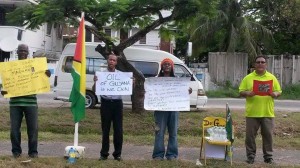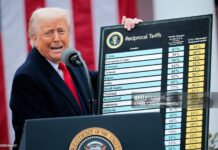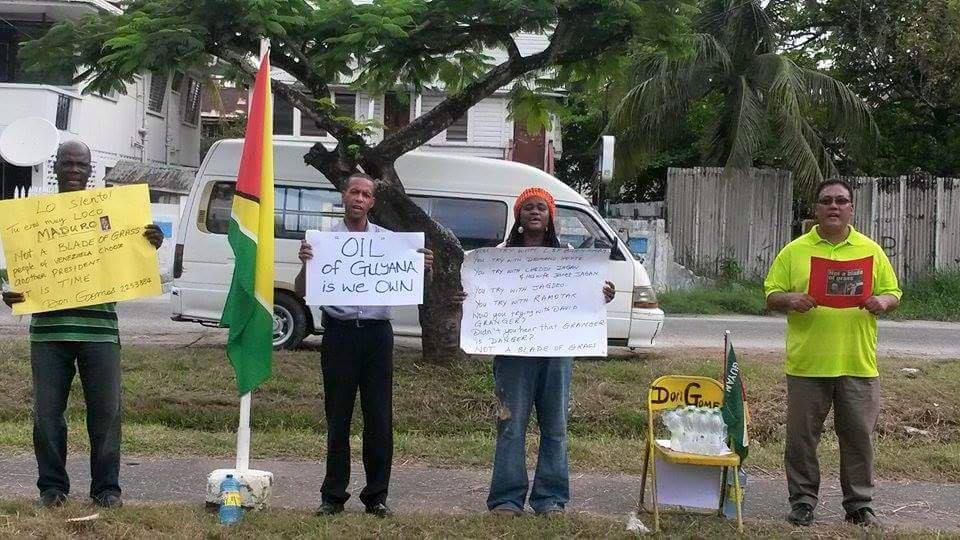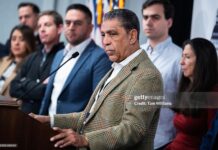
Julia Johnson Image/Facebook
News Americas, CARACAS, Venezuela, Weds. June 10, 2015: The question of whether the area called Essequibo in South America belongs to Guyana or Venezuela has raised its ugly head again on the heels of ExxonMobil’s recent announcement that it has found oil in the area’s waters.
Tensions escalated Tuesday as Venezuela’s foreign minister took to the airwaves to demand Guyana halt oil exploration in the disputed offshore territory while a handful of protestors in Guyana urged for the sitting Venezuelan ambassador to be send packing.
Venezuela Foreign Minister Delcy Rodriguez said Tuesday that “until there is a resolution of the issue of territorial reclamation… there can be no unilateral use of these waters.”
“The new government of Guyana shows a dangerous political provocation against a peaceful Venezuela, supported by the imperial power of an American transnational, ExxonMobil,” she added days after the May 27 claim to the Guyana territory by Venezuelan President Nicolas Maduro.
Picketing outside the local Venezuelan embassy on Thomas Street in Georgetown, Leader of the Independent Party, Mark Benschop called for Venezuelan Ambassador to Guyana Reina Margarita Arratia Diaz be declared ‘persona non grata’ and sent packing to her homeland.
The rising tensions have stirred passions on social media where many Guyanese quickly posted “Not a Blade of Grass,” a reference to a patriotic Guyanese song that emanated from the dispute in the 1980s.
Guyana’s new President David Granger for his part called Venezuela’s claim a “threat to regional peace and security” and a “flagrant violation of international law” even as Guyana’s Foreign Ministry warned that any attempt by Venezuela to enforce its claim would be “vigorously resisted.”
“It is international law that must reign supreme and not the ambitions of a larger State which wishes to trample upon the rights of a smaller country in order to obstruct the sovereign right of Guyana to develop its natural resources,” the statement said.
The Venezuelans insist the English-speaking nation is unfairly exploiting the disputed Essequibo territory that must be negotiated through a mechanism created via a 1966 treaty signed in Geneva.
THE HISTORY
Essequibo encompasses an area equivalent to around two-thirds of Guyanese territory. It was first included in the Viceroyalty of New Granada and the Captaincy General of Venezuela by Spain, but was later included in Essequibo by the Dutch and in British Guiana by the United Kingdom. Originally, parts of what is now eastern Venezuela were included in the disputed area.
The portion today under the administration of Guyana divides the area in six administrative regions (Barima-Waini, Cuyuni-Mazaruni, Pomeroon-Supenaam, Potaro-Siparuni, Upper Takutu-Upper Essequibo and Essequibo Islands-West Demerara), while Venezuela treats it as a single entity (Guayana Esequiba or “Zona en Reclamación”). This territory is 159,500 km².
The status of the territory is subject to the Treaty of Geneva, which was signed by the United Kingdom, Venezuela and British Guiana governments on February 17, 1966. This treaty stipulates that the parties will agree to find a practical, peaceful and satisfactory solution to the dispute.
In 1970, after the expiration of a Mixed Commission established according to the Treaty of Geneva, Presidents Rafael Caldera and Forbes Burnham signed the Port of Spain Protocol, which declared a 12 years moratorium on Venezuela’s reclamation of ‘Guayana Esequiba,’ with the purpose of allowing both governments to promote cooperation and understanding while the border claim was in abeyance.
In 1983 the deadline of the Port of Spain Protocol expired, and the Venezuelan President Luis Herrera Campins decided not to extend it anymore and resume the effective claim over the territory. Since then, the contacts between Venezuela and Guyana within the provisions of the Treaty of Geneva are under the recommendations of a UN Secretary General’s representative, who can be changed from time to time under agreement by both parties.
In September 2011, Guyana made an application before the United Nations’ Commission on the Limits of the Continental Shelf in order to extend its continental shelf by a further 150 nautical miles. Since the Commission requests that the areas to be considered cannot be subject to any kind of territorial disputes, the Guyanese application disregarded the Venezuelan claim over Guayana Esequiba, by saying that “there are no disputes in the region relevant to this submission of data and information relating to the outer limits of the continental shelf beyond 200 nautical miles.”
Venezuela sent an objection to the Commission, rejecting the Guyanese application and warning that Guyana had proposed a limit for its continental shelf including “the territory west of the Essequibo river, which is the subject of a territorial sovereignty dispute under the Geneva Agreement of 1966 and, within this framework, a matter for the good offices of the Secretary-General of the United Nations.”










